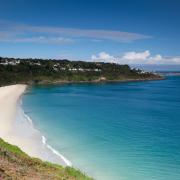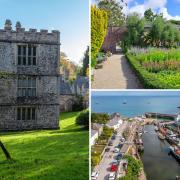With a treasure trove of recent discoveries, Charles and Lizzie Williams have grand plans to turn Caerhays Castle into a more lucrative venture without harming its heart, writes Paul White
With a treasure trove of recent discoveries, Charles and Lizzie Williams have grand plans to turn Caerhays Castle into a more lucrative venture without harming its heart, writes Paul White
Set in its own estate, in a picturesque – and bordering on secretive – setting on the beautiful southern coastline of Cornwall near St Austell, Caerhays Castle is a fascinating and historically significant element of the county’s heritage.Caerhays is already a popular visitor destination, but it is not in the big league, with, in each of the last two years, some 14,500 people paying for the experience. They came mainly to enjoy the 120 acres of magnificent gardens and to take a conducted tour of the house – an integral part of the castle.The house is home to the current owners, Charles Williams and his wife, Lizzie. Both have invested a great deal of time planning a busier and more lucrative future for the estate. But Charles is determined that an increase in visitor numbers and more awareness of all the estate has to offer, will not be achieved to the detriment of the landscape, amenity and overall environment that has characterised this estate for generations.A former merchant banker, he moved back to his childhood home with his family 26 years ago and set about improving the property and working towards running a profitable business based on Caerhays, while continuing to provide employment for local people. There are several distinct business strands at Caerhays. A visit here includes the house tour, the gardens, the beaches, a network of walks, holiday cottages, and an internationally renowned pheasant shoot. In addition, The Vean is an impressive restored Georgian lodge. This has been Lizzie’s project and the building, which stands in its own grounds within the estate, is now a popular venue for all manner of gatherings – from weddings and family parties to business events.Caerhays is run in tandem with Burncoose Nurseries, which has grown to become the second largest internet-based plant sales operation in the country. It is a highly sophisticated operation, achieving 15% annual growth, which shows no sign of slowing down. There is a strong trading link between Caerhays and Burncoose, which together generate roughly �5m in turnover each year, each enterprise contributing about 50%. “The growing is all done at Burncoose. Cutting material and seeds all come from Caerhays and we are working hard to amalgamate the two in the public mind,” says Charles. Camelias and rhododendrons – for which the Caerhays gardens are publicly and officially recognised – form the mainstay of the stock. But the business actively seeks out plants from around the world, which are little known in the domestic market. They grow their own stocks and buy in from specialist growers.Charles’ objective is to strengthen the link between the two enterprises in the minds of visitors and customers, and in doing so to build up trade. “People who buy plants at Burncoose should also be interested in the gardens at Caerhays. It’s that kind of cross-fertilisation that we aim to build upon,” he says.Coming back to Caerhays was always on the cards for Charles. “I took the view that my life’s work would be to modernise the estate; to revolutionise it.” He has researched, written and published a historical record of the estate and is uncovering some of its long-lost treasures. Designed by John Nash for the Trevanion family, Caerhays Castle was important in the 13th century, and by 1550 was one of the great houses of Cornwall. Charles’ new book, published this month, entitled Caerhays Castle, traces this history and delves even further back. Explorations have uncovered the site of an earlier mediaeval mansion, as well as the 7th- or 8th-century ditched farmstead that preceded it. The bankruptcy of the Trevanion family and their subsequent flight from not only the country but from Cornish history is a fascinating story. So too is the history of the Williams family, both in terms of their ownership of Caerhays and their prominence in the development of Cornwall’s mining industry.Today, the estate’s collection of camellias, rhododendrons, magnolias and other species is of national importance. At the turn of the 20th century, the Williams family sponsored plant hunters who brought back from south-west China many of the specimens that are well known today, but which were a complete revelation 120 years ago. These plant-hunting adventures are fully described in Charles’ book, as is the mineral collection, which has lain largely unnoticed and uncatalogued at various locations around the castle for over 100 years. Now the collection is receiving much attention and will form an important part of the house tour as work progresses.Newquay-based Courtenay V Smale was employed for most of his working life in the china clay industry. A former Newquay Grammar School pupil, he rose to become President of both the Royal Geographical Society of Cornwall and the Royal Institution of Cornwall, which is the owner of the famous Raleigh collection of minerals. In June 2008 he was invited by Charles Williams to assess the Caerhays collection, and was surprised by what he found. “There were some minerals in the glass cabinets but so much more not on display,” he says. He found “a cache of minerals” in cupboards, then “a horde in the cellar.”On the mantelpiece in the smoking room were topazes and aquamarines from Russia and new discoveries kept on happening: minerals in a chest of drawers in the old vegetable room and yet more in the old cold store. The cataloguing work continues and when completed, Courtenay is in no doubt that this will emerge as a collection to stir international interest. “So many of the old houses with mining connections in Cornwall had collections but most have disappeared, having been given to museums or sold.”Parts of the Caerhays collection have been donated or sold in the past but enough remains for this to be a highly significant collection, the story of which is described in Charles’ book. The author’s connection with the estate is strong. Around 50 people are employed here and there is an inter-dependence between the estate and its workforce. “Families that have worked on this estate for the last 100 years are still doing so today. There is continuity here; in 110 years we have had only four head gardeners. We would like to think that we are still a paternal estate, with all that is good about it, and paying people proper wages for doing difficult and intricate jobs,” Charles continues.Building the business will not be done at the expense of the landscape or the character of the estate. “I want to pass on a viable business to my son and see it stay a beautiful and wonderful place but with enough profitable business to stand on its own feet. I am a privileged man,” Charles recognises. “But with privilege comes enormous responsibility, which encompasses all the people who take their living from what I can achieve in business terms, to keep the whole thing carrying on.”
Caerhays Castle, St Austell, PL26 6LY. 01872 501310/501144, www.caerhays.co.uk


























